Toyota: Analysis of Leadership and Management Roles in Operations
VerifiedAdded on 2021/01/01
|16
|4706
|117
Report
AI Summary
This report provides an in-depth analysis of leadership and management within Toyota, a multinational automotive company. It begins with an introduction to Toyota's management structure, followed by a comparison of the roles of leaders and managers, including their characteristics and responsibilities. The report then delves into different leadership and management theories, such as contingency and situational theories, examining their strengths and weaknesses. Furthermore, it explores the roles of leaders and managers in various operational situations, such as maintaining product quality and adapting to market changes. The impact of leaders and managers on organizational working is discussed, with recommendations for improvements. The report provides a comprehensive overview of how effective leadership and management contribute to Toyota's success, covering key operational functions and the influence of the external business environment.
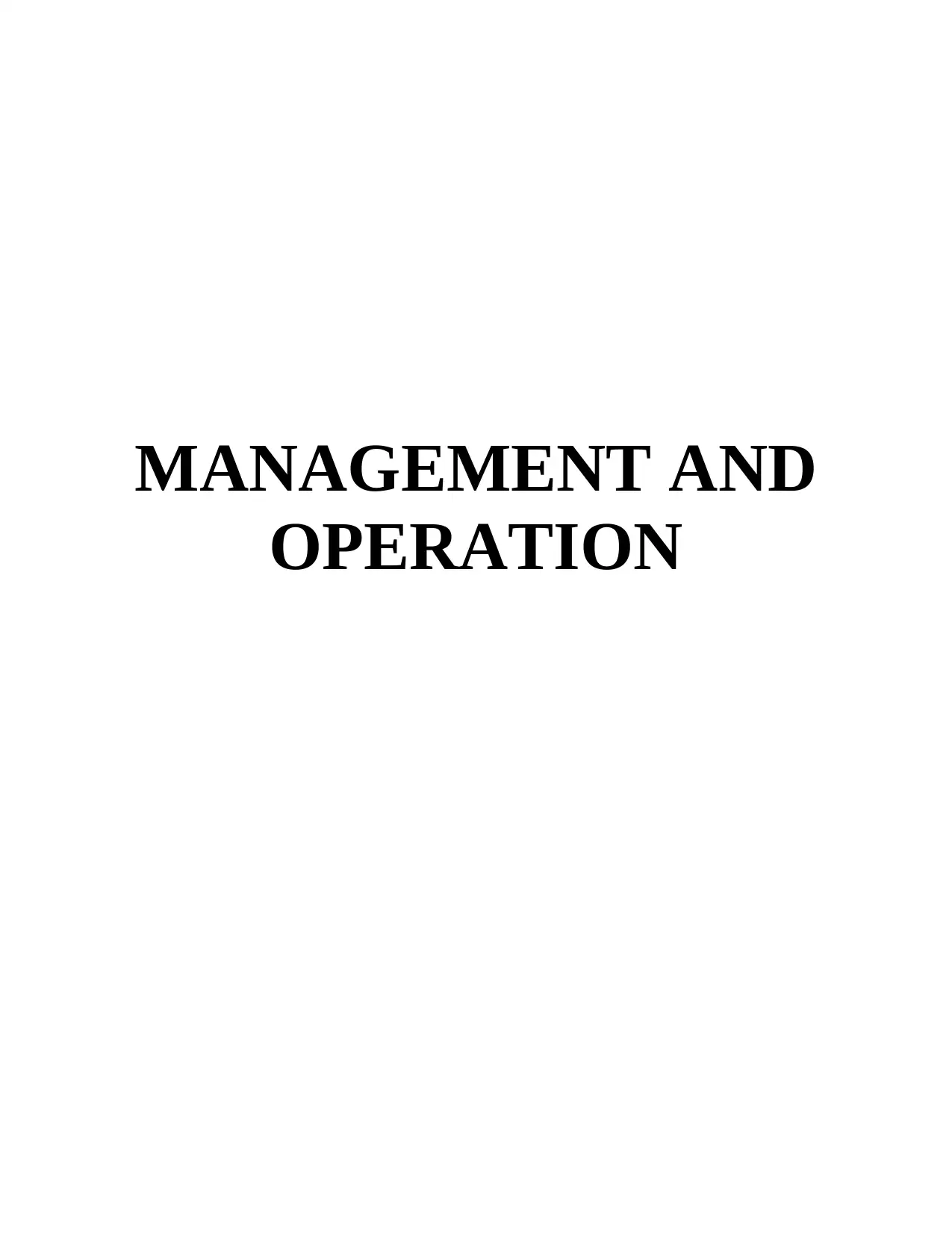
MANAGEMENT AND
OPERATION
OPERATION
Paraphrase This Document
Need a fresh take? Get an instant paraphrase of this document with our AI Paraphraser
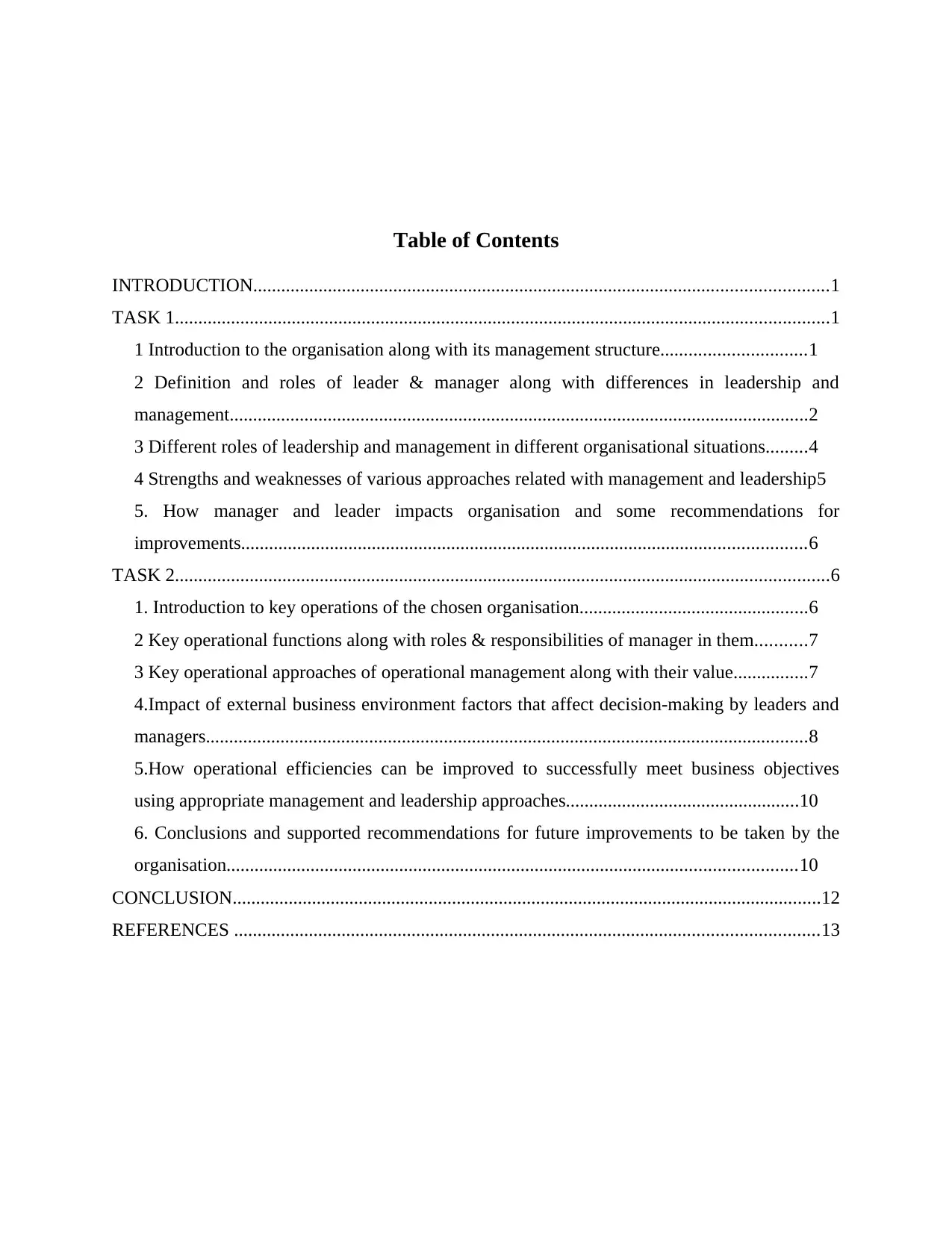
Table of Contents
INTRODUCTION...........................................................................................................................1
TASK 1............................................................................................................................................1
1 Introduction to the organisation along with its management structure...............................1
2 Definition and roles of leader & manager along with differences in leadership and
management............................................................................................................................2
3 Different roles of leadership and management in different organisational situations.........4
4 Strengths and weaknesses of various approaches related with management and leadership5
5. How manager and leader impacts organisation and some recommendations for
improvements.........................................................................................................................6
TASK 2............................................................................................................................................6
1. Introduction to key operations of the chosen organisation.................................................6
2 Key operational functions along with roles & responsibilities of manager in them...........7
3 Key operational approaches of operational management along with their value................7
4.Impact of external business environment factors that affect decision-making by leaders and
managers.................................................................................................................................8
5.How operational efficiencies can be improved to successfully meet business objectives
using appropriate management and leadership approaches..................................................10
6. Conclusions and supported recommendations for future improvements to be taken by the
organisation..........................................................................................................................10
CONCLUSION..............................................................................................................................12
REFERENCES .............................................................................................................................13
INTRODUCTION...........................................................................................................................1
TASK 1............................................................................................................................................1
1 Introduction to the organisation along with its management structure...............................1
2 Definition and roles of leader & manager along with differences in leadership and
management............................................................................................................................2
3 Different roles of leadership and management in different organisational situations.........4
4 Strengths and weaknesses of various approaches related with management and leadership5
5. How manager and leader impacts organisation and some recommendations for
improvements.........................................................................................................................6
TASK 2............................................................................................................................................6
1. Introduction to key operations of the chosen organisation.................................................6
2 Key operational functions along with roles & responsibilities of manager in them...........7
3 Key operational approaches of operational management along with their value................7
4.Impact of external business environment factors that affect decision-making by leaders and
managers.................................................................................................................................8
5.How operational efficiencies can be improved to successfully meet business objectives
using appropriate management and leadership approaches..................................................10
6. Conclusions and supported recommendations for future improvements to be taken by the
organisation..........................................................................................................................10
CONCLUSION..............................................................................................................................12
REFERENCES .............................................................................................................................13

⊘ This is a preview!⊘
Do you want full access?
Subscribe today to unlock all pages.

Trusted by 1+ million students worldwide
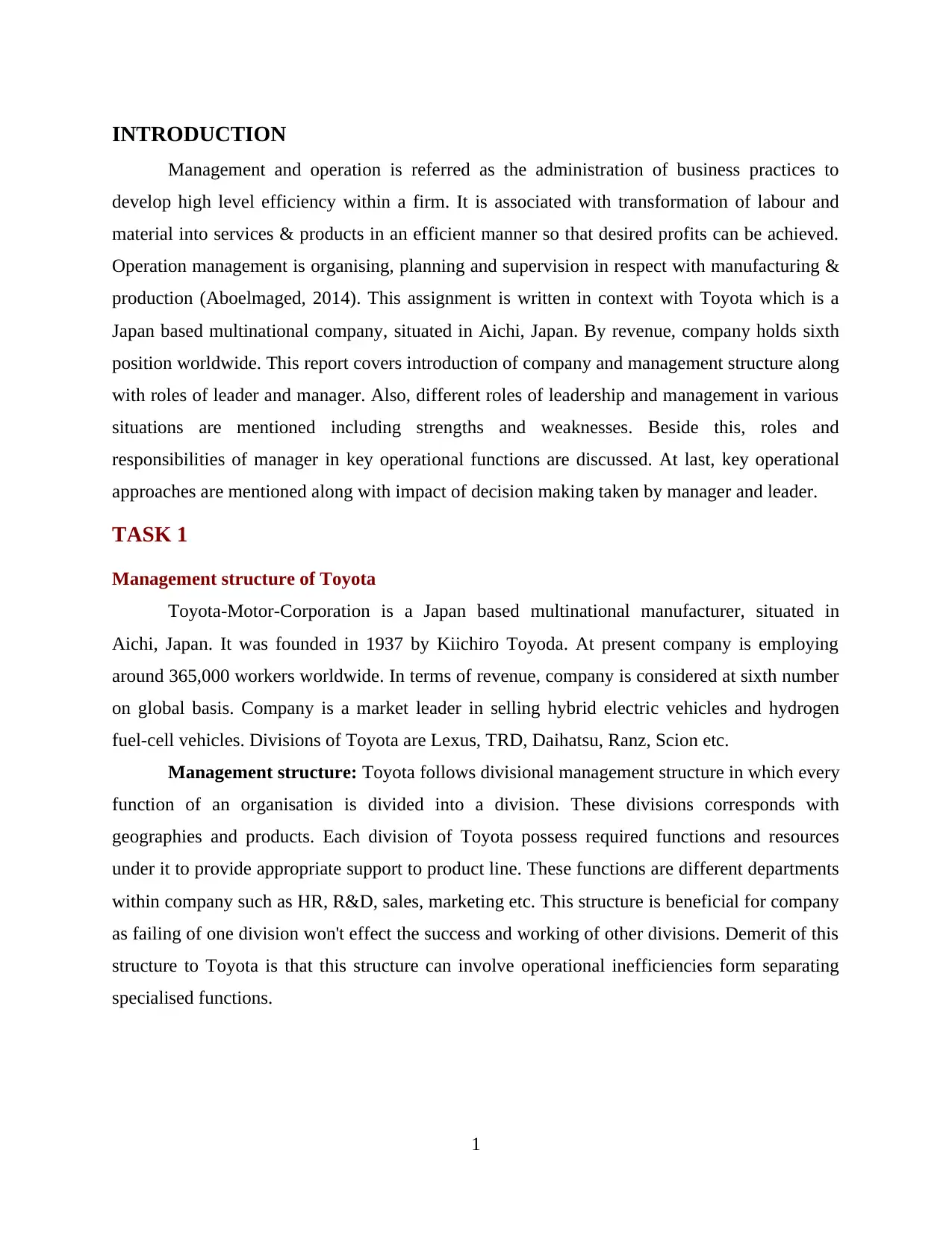
INTRODUCTION
Management and operation is referred as the administration of business practices to
develop high level efficiency within a firm. It is associated with transformation of labour and
material into services & products in an efficient manner so that desired profits can be achieved.
Operation management is organising, planning and supervision in respect with manufacturing &
production (Aboelmaged, 2014). This assignment is written in context with Toyota which is a
Japan based multinational company, situated in Aichi, Japan. By revenue, company holds sixth
position worldwide. This report covers introduction of company and management structure along
with roles of leader and manager. Also, different roles of leadership and management in various
situations are mentioned including strengths and weaknesses. Beside this, roles and
responsibilities of manager in key operational functions are discussed. At last, key operational
approaches are mentioned along with impact of decision making taken by manager and leader.
TASK 1
Management structure of Toyota
Toyota-Motor-Corporation is a Japan based multinational manufacturer, situated in
Aichi, Japan. It was founded in 1937 by Kiichiro Toyoda. At present company is employing
around 365,000 workers worldwide. In terms of revenue, company is considered at sixth number
on global basis. Company is a market leader in selling hybrid electric vehicles and hydrogen
fuel-cell vehicles. Divisions of Toyota are Lexus, TRD, Daihatsu, Ranz, Scion etc.
Management structure: Toyota follows divisional management structure in which every
function of an organisation is divided into a division. These divisions corresponds with
geographies and products. Each division of Toyota possess required functions and resources
under it to provide appropriate support to product line. These functions are different departments
within company such as HR, R&D, sales, marketing etc. This structure is beneficial for company
as failing of one division won't effect the success and working of other divisions. Demerit of this
structure to Toyota is that this structure can involve operational inefficiencies form separating
specialised functions.
1
Management and operation is referred as the administration of business practices to
develop high level efficiency within a firm. It is associated with transformation of labour and
material into services & products in an efficient manner so that desired profits can be achieved.
Operation management is organising, planning and supervision in respect with manufacturing &
production (Aboelmaged, 2014). This assignment is written in context with Toyota which is a
Japan based multinational company, situated in Aichi, Japan. By revenue, company holds sixth
position worldwide. This report covers introduction of company and management structure along
with roles of leader and manager. Also, different roles of leadership and management in various
situations are mentioned including strengths and weaknesses. Beside this, roles and
responsibilities of manager in key operational functions are discussed. At last, key operational
approaches are mentioned along with impact of decision making taken by manager and leader.
TASK 1
Management structure of Toyota
Toyota-Motor-Corporation is a Japan based multinational manufacturer, situated in
Aichi, Japan. It was founded in 1937 by Kiichiro Toyoda. At present company is employing
around 365,000 workers worldwide. In terms of revenue, company is considered at sixth number
on global basis. Company is a market leader in selling hybrid electric vehicles and hydrogen
fuel-cell vehicles. Divisions of Toyota are Lexus, TRD, Daihatsu, Ranz, Scion etc.
Management structure: Toyota follows divisional management structure in which every
function of an organisation is divided into a division. These divisions corresponds with
geographies and products. Each division of Toyota possess required functions and resources
under it to provide appropriate support to product line. These functions are different departments
within company such as HR, R&D, sales, marketing etc. This structure is beneficial for company
as failing of one division won't effect the success and working of other divisions. Demerit of this
structure to Toyota is that this structure can involve operational inefficiencies form separating
specialised functions.
1
Paraphrase This Document
Need a fresh take? Get an instant paraphrase of this document with our AI Paraphraser
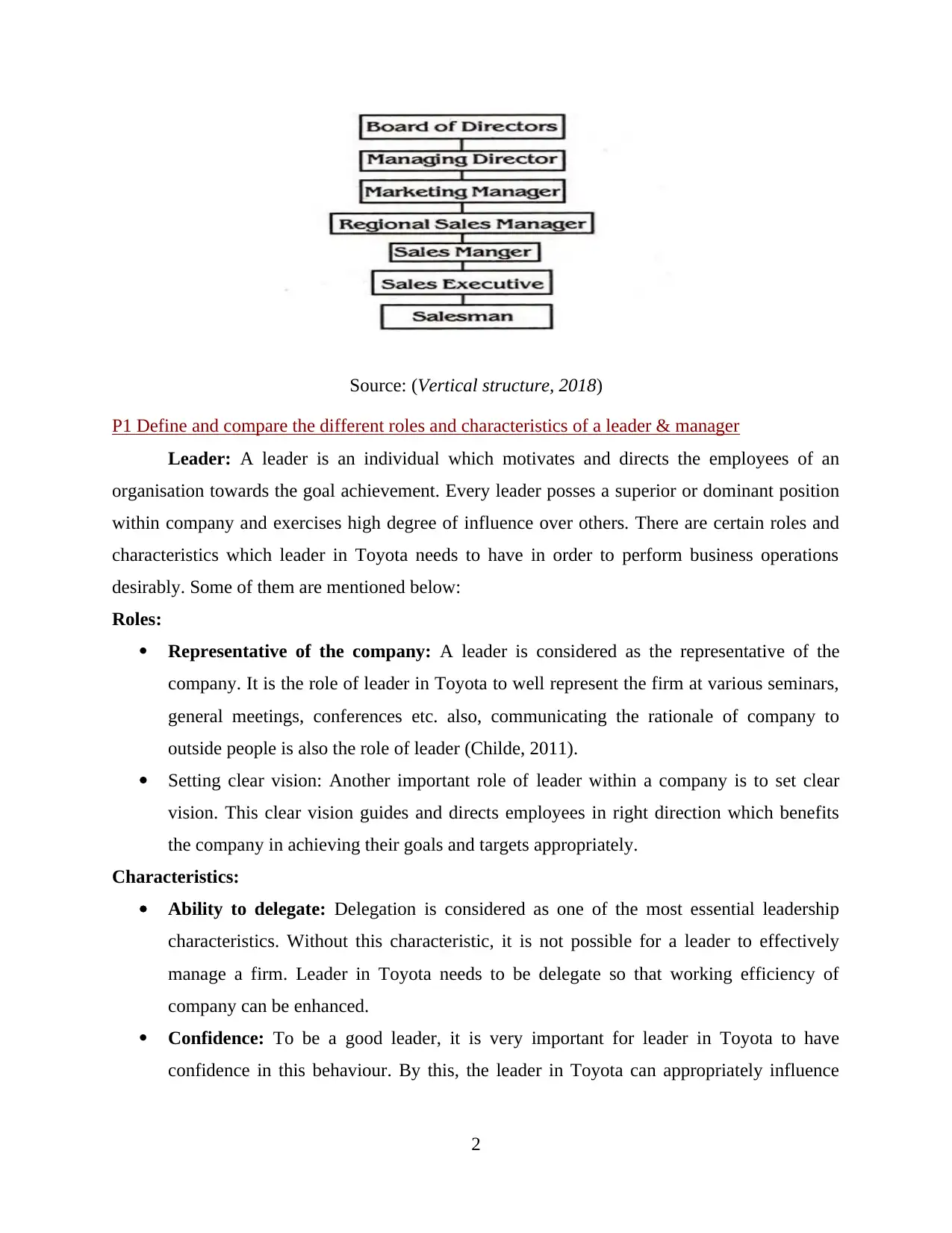
Source: (Vertical structure, 2018)
P1 Define and compare the different roles and characteristics of a leader & manager
Leader: A leader is an individual which motivates and directs the employees of an
organisation towards the goal achievement. Every leader posses a superior or dominant position
within company and exercises high degree of influence over others. There are certain roles and
characteristics which leader in Toyota needs to have in order to perform business operations
desirably. Some of them are mentioned below:
Roles:
Representative of the company: A leader is considered as the representative of the
company. It is the role of leader in Toyota to well represent the firm at various seminars,
general meetings, conferences etc. also, communicating the rationale of company to
outside people is also the role of leader (Childe, 2011).
Setting clear vision: Another important role of leader within a company is to set clear
vision. This clear vision guides and directs employees in right direction which benefits
the company in achieving their goals and targets appropriately.
Characteristics:
Ability to delegate: Delegation is considered as one of the most essential leadership
characteristics. Without this characteristic, it is not possible for a leader to effectively
manage a firm. Leader in Toyota needs to be delegate so that working efficiency of
company can be enhanced.
Confidence: To be a good leader, it is very important for leader in Toyota to have
confidence in this behaviour. By this, the leader in Toyota can appropriately influence
2
P1 Define and compare the different roles and characteristics of a leader & manager
Leader: A leader is an individual which motivates and directs the employees of an
organisation towards the goal achievement. Every leader posses a superior or dominant position
within company and exercises high degree of influence over others. There are certain roles and
characteristics which leader in Toyota needs to have in order to perform business operations
desirably. Some of them are mentioned below:
Roles:
Representative of the company: A leader is considered as the representative of the
company. It is the role of leader in Toyota to well represent the firm at various seminars,
general meetings, conferences etc. also, communicating the rationale of company to
outside people is also the role of leader (Childe, 2011).
Setting clear vision: Another important role of leader within a company is to set clear
vision. This clear vision guides and directs employees in right direction which benefits
the company in achieving their goals and targets appropriately.
Characteristics:
Ability to delegate: Delegation is considered as one of the most essential leadership
characteristics. Without this characteristic, it is not possible for a leader to effectively
manage a firm. Leader in Toyota needs to be delegate so that working efficiency of
company can be enhanced.
Confidence: To be a good leader, it is very important for leader in Toyota to have
confidence in this behaviour. By this, the leader in Toyota can appropriately influence
2
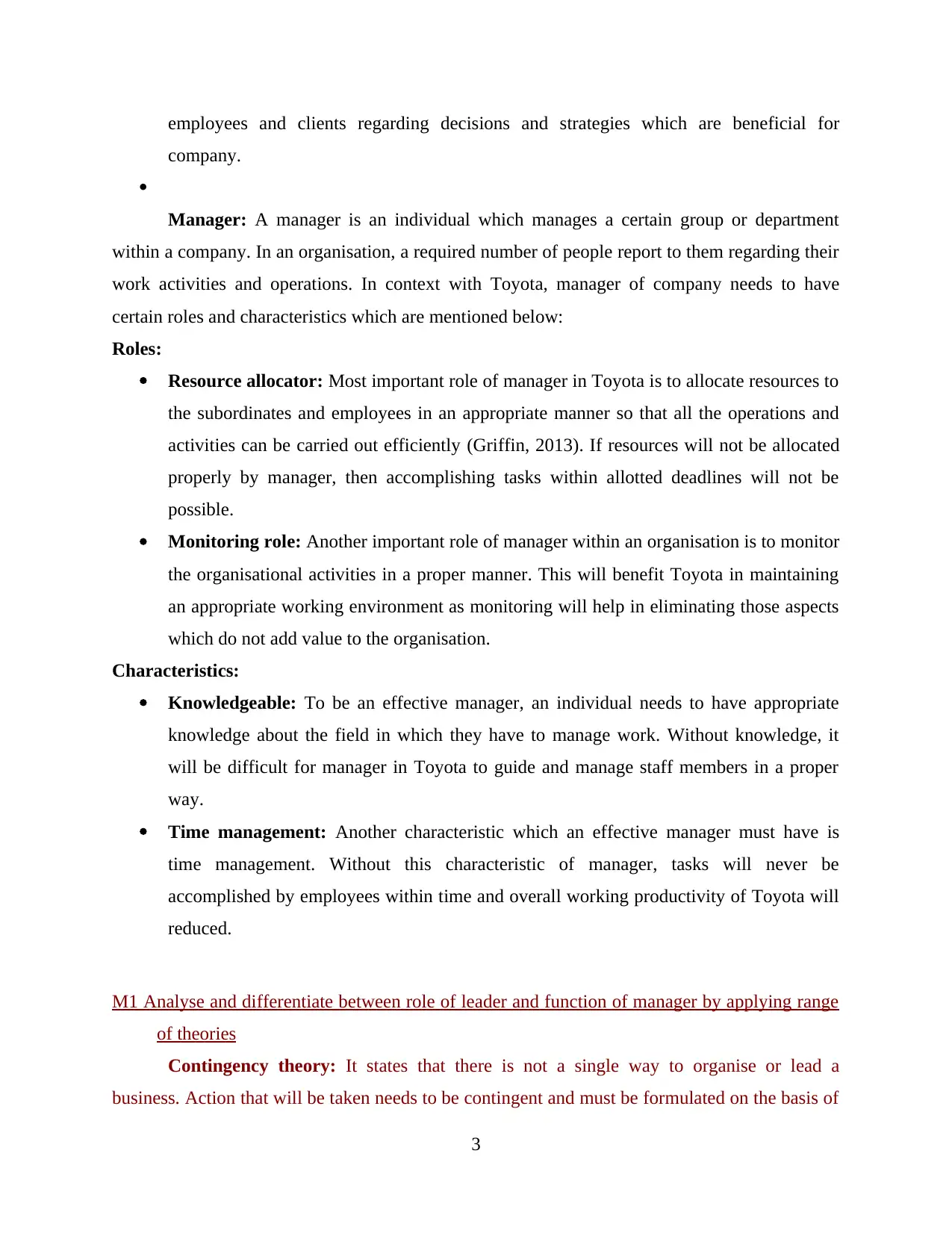
employees and clients regarding decisions and strategies which are beneficial for
company.
Manager: A manager is an individual which manages a certain group or department
within a company. In an organisation, a required number of people report to them regarding their
work activities and operations. In context with Toyota, manager of company needs to have
certain roles and characteristics which are mentioned below:
Roles:
Resource allocator: Most important role of manager in Toyota is to allocate resources to
the subordinates and employees in an appropriate manner so that all the operations and
activities can be carried out efficiently (Griffin, 2013). If resources will not be allocated
properly by manager, then accomplishing tasks within allotted deadlines will not be
possible.
Monitoring role: Another important role of manager within an organisation is to monitor
the organisational activities in a proper manner. This will benefit Toyota in maintaining
an appropriate working environment as monitoring will help in eliminating those aspects
which do not add value to the organisation.
Characteristics:
Knowledgeable: To be an effective manager, an individual needs to have appropriate
knowledge about the field in which they have to manage work. Without knowledge, it
will be difficult for manager in Toyota to guide and manage staff members in a proper
way.
Time management: Another characteristic which an effective manager must have is
time management. Without this characteristic of manager, tasks will never be
accomplished by employees within time and overall working productivity of Toyota will
reduced.
M1 Analyse and differentiate between role of leader and function of manager by applying range
of theories
Contingency theory: It states that there is not a single way to organise or lead a
business. Action that will be taken needs to be contingent and must be formulated on the basis of
3
company.
Manager: A manager is an individual which manages a certain group or department
within a company. In an organisation, a required number of people report to them regarding their
work activities and operations. In context with Toyota, manager of company needs to have
certain roles and characteristics which are mentioned below:
Roles:
Resource allocator: Most important role of manager in Toyota is to allocate resources to
the subordinates and employees in an appropriate manner so that all the operations and
activities can be carried out efficiently (Griffin, 2013). If resources will not be allocated
properly by manager, then accomplishing tasks within allotted deadlines will not be
possible.
Monitoring role: Another important role of manager within an organisation is to monitor
the organisational activities in a proper manner. This will benefit Toyota in maintaining
an appropriate working environment as monitoring will help in eliminating those aspects
which do not add value to the organisation.
Characteristics:
Knowledgeable: To be an effective manager, an individual needs to have appropriate
knowledge about the field in which they have to manage work. Without knowledge, it
will be difficult for manager in Toyota to guide and manage staff members in a proper
way.
Time management: Another characteristic which an effective manager must have is
time management. Without this characteristic of manager, tasks will never be
accomplished by employees within time and overall working productivity of Toyota will
reduced.
M1 Analyse and differentiate between role of leader and function of manager by applying range
of theories
Contingency theory: It states that there is not a single way to organise or lead a
business. Action that will be taken needs to be contingent and must be formulated on the basis of
3
⊘ This is a preview!⊘
Do you want full access?
Subscribe today to unlock all pages.

Trusted by 1+ million students worldwide
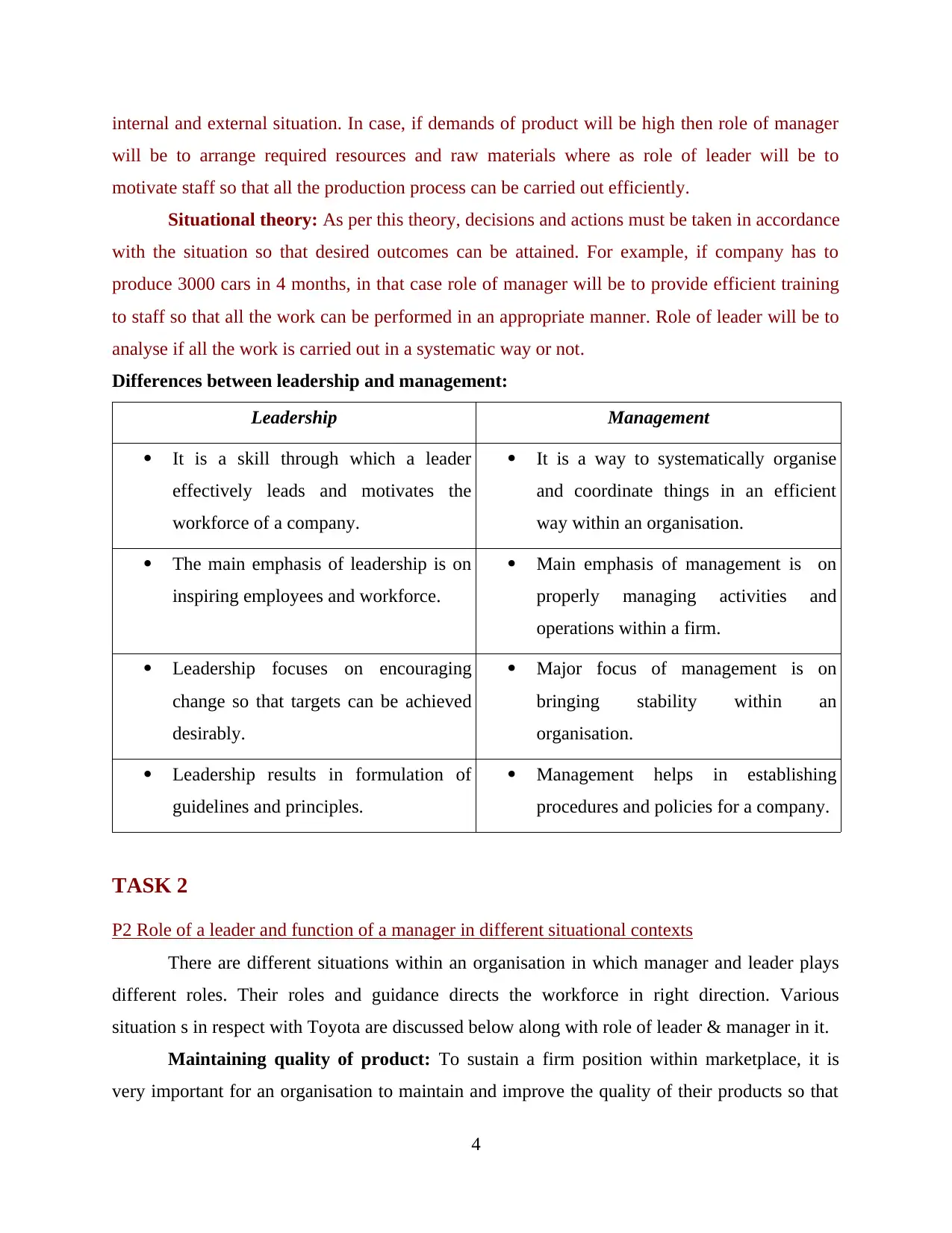
internal and external situation. In case, if demands of product will be high then role of manager
will be to arrange required resources and raw materials where as role of leader will be to
motivate staff so that all the production process can be carried out efficiently.
Situational theory: As per this theory, decisions and actions must be taken in accordance
with the situation so that desired outcomes can be attained. For example, if company has to
produce 3000 cars in 4 months, in that case role of manager will be to provide efficient training
to staff so that all the work can be performed in an appropriate manner. Role of leader will be to
analyse if all the work is carried out in a systematic way or not.
Differences between leadership and management:
Leadership Management
It is a skill through which a leader
effectively leads and motivates the
workforce of a company.
It is a way to systematically organise
and coordinate things in an efficient
way within an organisation.
The main emphasis of leadership is on
inspiring employees and workforce.
Main emphasis of management is on
properly managing activities and
operations within a firm.
Leadership focuses on encouraging
change so that targets can be achieved
desirably.
Major focus of management is on
bringing stability within an
organisation.
Leadership results in formulation of
guidelines and principles.
Management helps in establishing
procedures and policies for a company.
TASK 2
P2 Role of a leader and function of a manager in different situational contexts
There are different situations within an organisation in which manager and leader plays
different roles. Their roles and guidance directs the workforce in right direction. Various
situation s in respect with Toyota are discussed below along with role of leader & manager in it.
Maintaining quality of product: To sustain a firm position within marketplace, it is
very important for an organisation to maintain and improve the quality of their products so that
4
will be to arrange required resources and raw materials where as role of leader will be to
motivate staff so that all the production process can be carried out efficiently.
Situational theory: As per this theory, decisions and actions must be taken in accordance
with the situation so that desired outcomes can be attained. For example, if company has to
produce 3000 cars in 4 months, in that case role of manager will be to provide efficient training
to staff so that all the work can be performed in an appropriate manner. Role of leader will be to
analyse if all the work is carried out in a systematic way or not.
Differences between leadership and management:
Leadership Management
It is a skill through which a leader
effectively leads and motivates the
workforce of a company.
It is a way to systematically organise
and coordinate things in an efficient
way within an organisation.
The main emphasis of leadership is on
inspiring employees and workforce.
Main emphasis of management is on
properly managing activities and
operations within a firm.
Leadership focuses on encouraging
change so that targets can be achieved
desirably.
Major focus of management is on
bringing stability within an
organisation.
Leadership results in formulation of
guidelines and principles.
Management helps in establishing
procedures and policies for a company.
TASK 2
P2 Role of a leader and function of a manager in different situational contexts
There are different situations within an organisation in which manager and leader plays
different roles. Their roles and guidance directs the workforce in right direction. Various
situation s in respect with Toyota are discussed below along with role of leader & manager in it.
Maintaining quality of product: To sustain a firm position within marketplace, it is
very important for an organisation to maintain and improve the quality of their products so that
4
Paraphrase This Document
Need a fresh take? Get an instant paraphrase of this document with our AI Paraphraser
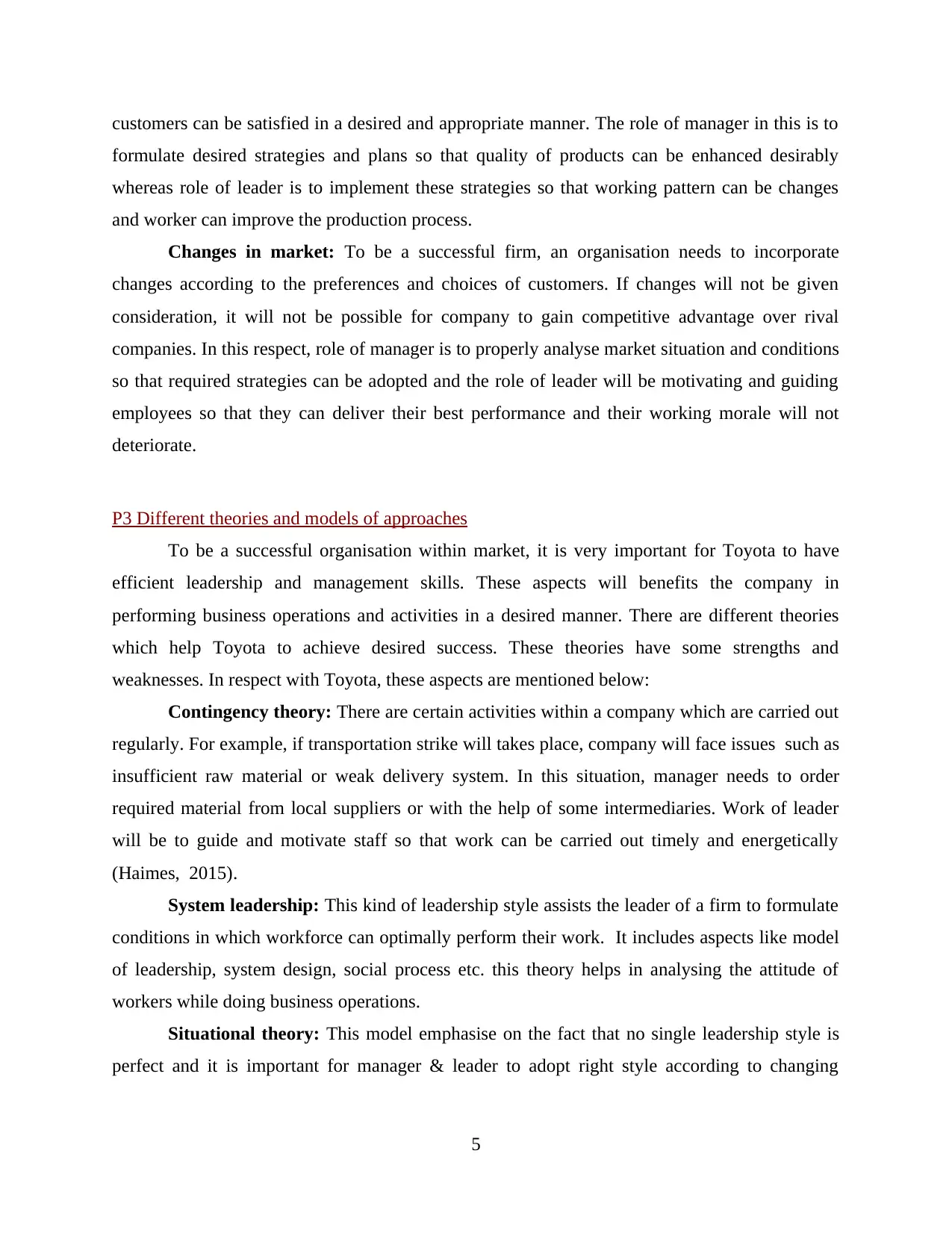
customers can be satisfied in a desired and appropriate manner. The role of manager in this is to
formulate desired strategies and plans so that quality of products can be enhanced desirably
whereas role of leader is to implement these strategies so that working pattern can be changes
and worker can improve the production process.
Changes in market: To be a successful firm, an organisation needs to incorporate
changes according to the preferences and choices of customers. If changes will not be given
consideration, it will not be possible for company to gain competitive advantage over rival
companies. In this respect, role of manager is to properly analyse market situation and conditions
so that required strategies can be adopted and the role of leader will be motivating and guiding
employees so that they can deliver their best performance and their working morale will not
deteriorate.
P3 Different theories and models of approaches
To be a successful organisation within market, it is very important for Toyota to have
efficient leadership and management skills. These aspects will benefits the company in
performing business operations and activities in a desired manner. There are different theories
which help Toyota to achieve desired success. These theories have some strengths and
weaknesses. In respect with Toyota, these aspects are mentioned below:
Contingency theory: There are certain activities within a company which are carried out
regularly. For example, if transportation strike will takes place, company will face issues such as
insufficient raw material or weak delivery system. In this situation, manager needs to order
required material from local suppliers or with the help of some intermediaries. Work of leader
will be to guide and motivate staff so that work can be carried out timely and energetically
(Haimes, 2015).
System leadership: This kind of leadership style assists the leader of a firm to formulate
conditions in which workforce can optimally perform their work. It includes aspects like model
of leadership, system design, social process etc. this theory helps in analysing the attitude of
workers while doing business operations.
Situational theory: This model emphasise on the fact that no single leadership style is
perfect and it is important for manager & leader to adopt right style according to changing
5
formulate desired strategies and plans so that quality of products can be enhanced desirably
whereas role of leader is to implement these strategies so that working pattern can be changes
and worker can improve the production process.
Changes in market: To be a successful firm, an organisation needs to incorporate
changes according to the preferences and choices of customers. If changes will not be given
consideration, it will not be possible for company to gain competitive advantage over rival
companies. In this respect, role of manager is to properly analyse market situation and conditions
so that required strategies can be adopted and the role of leader will be motivating and guiding
employees so that they can deliver their best performance and their working morale will not
deteriorate.
P3 Different theories and models of approaches
To be a successful organisation within market, it is very important for Toyota to have
efficient leadership and management skills. These aspects will benefits the company in
performing business operations and activities in a desired manner. There are different theories
which help Toyota to achieve desired success. These theories have some strengths and
weaknesses. In respect with Toyota, these aspects are mentioned below:
Contingency theory: There are certain activities within a company which are carried out
regularly. For example, if transportation strike will takes place, company will face issues such as
insufficient raw material or weak delivery system. In this situation, manager needs to order
required material from local suppliers or with the help of some intermediaries. Work of leader
will be to guide and motivate staff so that work can be carried out timely and energetically
(Haimes, 2015).
System leadership: This kind of leadership style assists the leader of a firm to formulate
conditions in which workforce can optimally perform their work. It includes aspects like model
of leadership, system design, social process etc. this theory helps in analysing the attitude of
workers while doing business operations.
Situational theory: This model emphasise on the fact that no single leadership style is
perfect and it is important for manager & leader to adopt right style according to changing
5
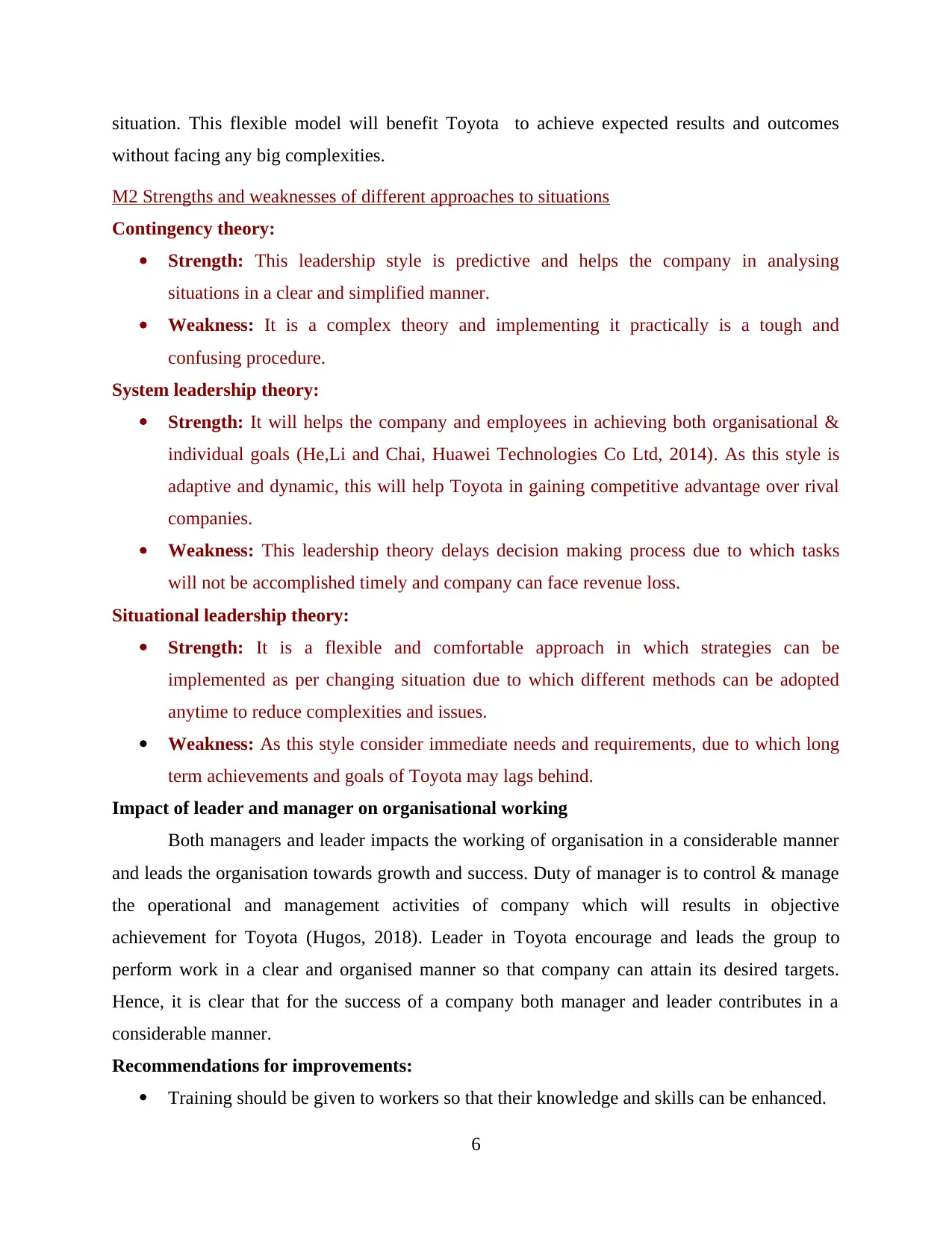
situation. This flexible model will benefit Toyota to achieve expected results and outcomes
without facing any big complexities.
M2 Strengths and weaknesses of different approaches to situations
Contingency theory:
Strength: This leadership style is predictive and helps the company in analysing
situations in a clear and simplified manner.
Weakness: It is a complex theory and implementing it practically is a tough and
confusing procedure.
System leadership theory:
Strength: It will helps the company and employees in achieving both organisational &
individual goals (He,Li and Chai, Huawei Technologies Co Ltd, 2014). As this style is
adaptive and dynamic, this will help Toyota in gaining competitive advantage over rival
companies.
Weakness: This leadership theory delays decision making process due to which tasks
will not be accomplished timely and company can face revenue loss.
Situational leadership theory:
Strength: It is a flexible and comfortable approach in which strategies can be
implemented as per changing situation due to which different methods can be adopted
anytime to reduce complexities and issues.
Weakness: As this style consider immediate needs and requirements, due to which long
term achievements and goals of Toyota may lags behind.
Impact of leader and manager on organisational working
Both managers and leader impacts the working of organisation in a considerable manner
and leads the organisation towards growth and success. Duty of manager is to control & manage
the operational and management activities of company which will results in objective
achievement for Toyota (Hugos, 2018). Leader in Toyota encourage and leads the group to
perform work in a clear and organised manner so that company can attain its desired targets.
Hence, it is clear that for the success of a company both manager and leader contributes in a
considerable manner.
Recommendations for improvements:
Training should be given to workers so that their knowledge and skills can be enhanced.
6
without facing any big complexities.
M2 Strengths and weaknesses of different approaches to situations
Contingency theory:
Strength: This leadership style is predictive and helps the company in analysing
situations in a clear and simplified manner.
Weakness: It is a complex theory and implementing it practically is a tough and
confusing procedure.
System leadership theory:
Strength: It will helps the company and employees in achieving both organisational &
individual goals (He,Li and Chai, Huawei Technologies Co Ltd, 2014). As this style is
adaptive and dynamic, this will help Toyota in gaining competitive advantage over rival
companies.
Weakness: This leadership theory delays decision making process due to which tasks
will not be accomplished timely and company can face revenue loss.
Situational leadership theory:
Strength: It is a flexible and comfortable approach in which strategies can be
implemented as per changing situation due to which different methods can be adopted
anytime to reduce complexities and issues.
Weakness: As this style consider immediate needs and requirements, due to which long
term achievements and goals of Toyota may lags behind.
Impact of leader and manager on organisational working
Both managers and leader impacts the working of organisation in a considerable manner
and leads the organisation towards growth and success. Duty of manager is to control & manage
the operational and management activities of company which will results in objective
achievement for Toyota (Hugos, 2018). Leader in Toyota encourage and leads the group to
perform work in a clear and organised manner so that company can attain its desired targets.
Hence, it is clear that for the success of a company both manager and leader contributes in a
considerable manner.
Recommendations for improvements:
Training should be given to workers so that their knowledge and skills can be enhanced.
6
⊘ This is a preview!⊘
Do you want full access?
Subscribe today to unlock all pages.

Trusted by 1+ million students worldwide
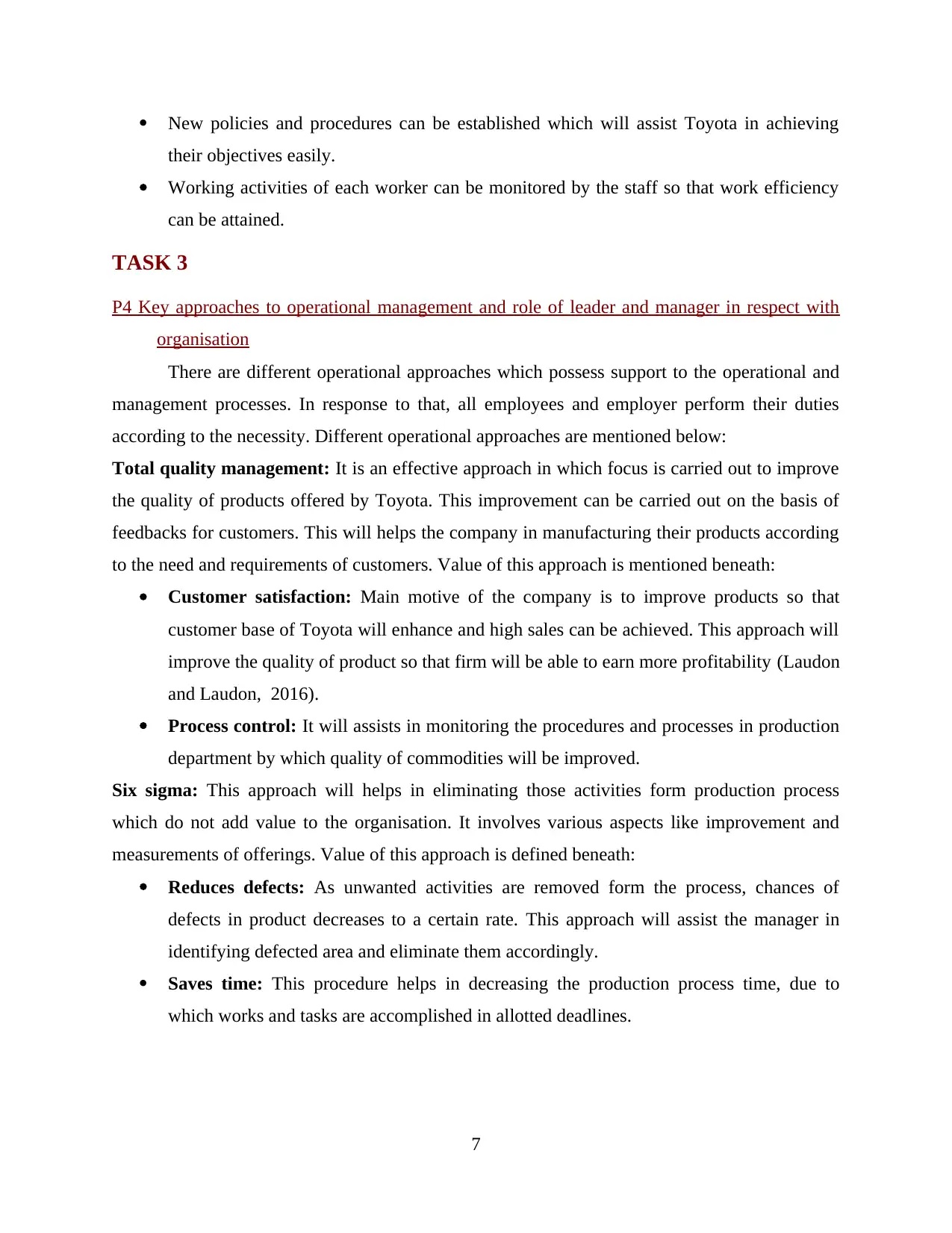
New policies and procedures can be established which will assist Toyota in achieving
their objectives easily.
Working activities of each worker can be monitored by the staff so that work efficiency
can be attained.
TASK 3
P4 Key approaches to operational management and role of leader and manager in respect with
organisation
There are different operational approaches which possess support to the operational and
management processes. In response to that, all employees and employer perform their duties
according to the necessity. Different operational approaches are mentioned below:
Total quality management: It is an effective approach in which focus is carried out to improve
the quality of products offered by Toyota. This improvement can be carried out on the basis of
feedbacks for customers. This will helps the company in manufacturing their products according
to the need and requirements of customers. Value of this approach is mentioned beneath:
Customer satisfaction: Main motive of the company is to improve products so that
customer base of Toyota will enhance and high sales can be achieved. This approach will
improve the quality of product so that firm will be able to earn more profitability (Laudon
and Laudon, 2016).
Process control: It will assists in monitoring the procedures and processes in production
department by which quality of commodities will be improved.
Six sigma: This approach will helps in eliminating those activities form production process
which do not add value to the organisation. It involves various aspects like improvement and
measurements of offerings. Value of this approach is defined beneath:
Reduces defects: As unwanted activities are removed form the process, chances of
defects in product decreases to a certain rate. This approach will assist the manager in
identifying defected area and eliminate them accordingly.
Saves time: This procedure helps in decreasing the production process time, due to
which works and tasks are accomplished in allotted deadlines.
7
their objectives easily.
Working activities of each worker can be monitored by the staff so that work efficiency
can be attained.
TASK 3
P4 Key approaches to operational management and role of leader and manager in respect with
organisation
There are different operational approaches which possess support to the operational and
management processes. In response to that, all employees and employer perform their duties
according to the necessity. Different operational approaches are mentioned below:
Total quality management: It is an effective approach in which focus is carried out to improve
the quality of products offered by Toyota. This improvement can be carried out on the basis of
feedbacks for customers. This will helps the company in manufacturing their products according
to the need and requirements of customers. Value of this approach is mentioned beneath:
Customer satisfaction: Main motive of the company is to improve products so that
customer base of Toyota will enhance and high sales can be achieved. This approach will
improve the quality of product so that firm will be able to earn more profitability (Laudon
and Laudon, 2016).
Process control: It will assists in monitoring the procedures and processes in production
department by which quality of commodities will be improved.
Six sigma: This approach will helps in eliminating those activities form production process
which do not add value to the organisation. It involves various aspects like improvement and
measurements of offerings. Value of this approach is defined beneath:
Reduces defects: As unwanted activities are removed form the process, chances of
defects in product decreases to a certain rate. This approach will assist the manager in
identifying defected area and eliminate them accordingly.
Saves time: This procedure helps in decreasing the production process time, due to
which works and tasks are accomplished in allotted deadlines.
7
Paraphrase This Document
Need a fresh take? Get an instant paraphrase of this document with our AI Paraphraser
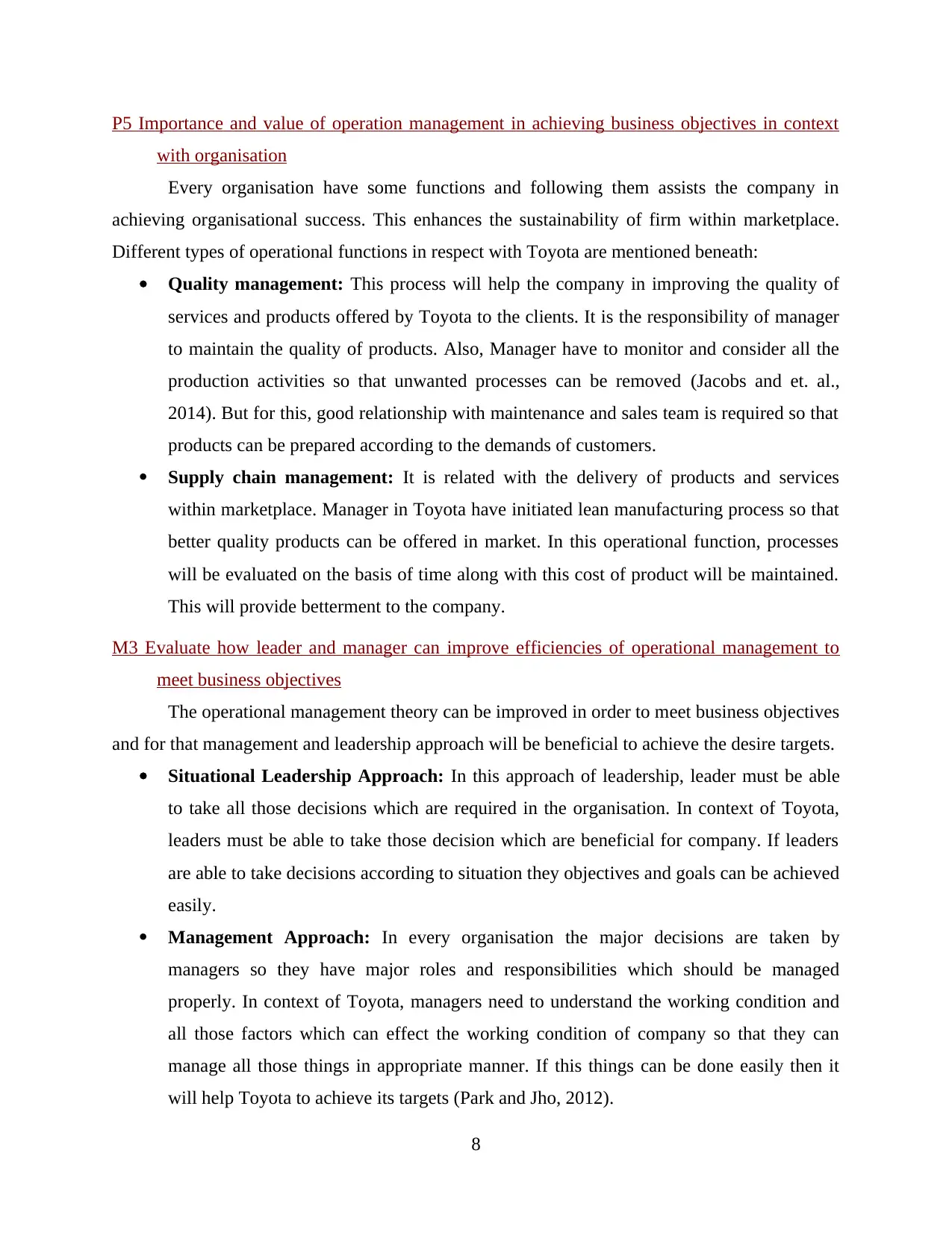
P5 Importance and value of operation management in achieving business objectives in context
with organisation
Every organisation have some functions and following them assists the company in
achieving organisational success. This enhances the sustainability of firm within marketplace.
Different types of operational functions in respect with Toyota are mentioned beneath:
Quality management: This process will help the company in improving the quality of
services and products offered by Toyota to the clients. It is the responsibility of manager
to maintain the quality of products. Also, Manager have to monitor and consider all the
production activities so that unwanted processes can be removed (Jacobs and et. al.,
2014). But for this, good relationship with maintenance and sales team is required so that
products can be prepared according to the demands of customers.
Supply chain management: It is related with the delivery of products and services
within marketplace. Manager in Toyota have initiated lean manufacturing process so that
better quality products can be offered in market. In this operational function, processes
will be evaluated on the basis of time along with this cost of product will be maintained.
This will provide betterment to the company.
M3 Evaluate how leader and manager can improve efficiencies of operational management to
meet business objectives
The operational management theory can be improved in order to meet business objectives
and for that management and leadership approach will be beneficial to achieve the desire targets.
Situational Leadership Approach: In this approach of leadership, leader must be able
to take all those decisions which are required in the organisation. In context of Toyota,
leaders must be able to take those decision which are beneficial for company. If leaders
are able to take decisions according to situation they objectives and goals can be achieved
easily.
Management Approach: In every organisation the major decisions are taken by
managers so they have major roles and responsibilities which should be managed
properly. In context of Toyota, managers need to understand the working condition and
all those factors which can effect the working condition of company so that they can
manage all those things in appropriate manner. If this things can be done easily then it
will help Toyota to achieve its targets (Park and Jho, 2012).
8
with organisation
Every organisation have some functions and following them assists the company in
achieving organisational success. This enhances the sustainability of firm within marketplace.
Different types of operational functions in respect with Toyota are mentioned beneath:
Quality management: This process will help the company in improving the quality of
services and products offered by Toyota to the clients. It is the responsibility of manager
to maintain the quality of products. Also, Manager have to monitor and consider all the
production activities so that unwanted processes can be removed (Jacobs and et. al.,
2014). But for this, good relationship with maintenance and sales team is required so that
products can be prepared according to the demands of customers.
Supply chain management: It is related with the delivery of products and services
within marketplace. Manager in Toyota have initiated lean manufacturing process so that
better quality products can be offered in market. In this operational function, processes
will be evaluated on the basis of time along with this cost of product will be maintained.
This will provide betterment to the company.
M3 Evaluate how leader and manager can improve efficiencies of operational management to
meet business objectives
The operational management theory can be improved in order to meet business objectives
and for that management and leadership approach will be beneficial to achieve the desire targets.
Situational Leadership Approach: In this approach of leadership, leader must be able
to take all those decisions which are required in the organisation. In context of Toyota,
leaders must be able to take those decision which are beneficial for company. If leaders
are able to take decisions according to situation they objectives and goals can be achieved
easily.
Management Approach: In every organisation the major decisions are taken by
managers so they have major roles and responsibilities which should be managed
properly. In context of Toyota, managers need to understand the working condition and
all those factors which can effect the working condition of company so that they can
manage all those things in appropriate manner. If this things can be done easily then it
will help Toyota to achieve its targets (Park and Jho, 2012).
8
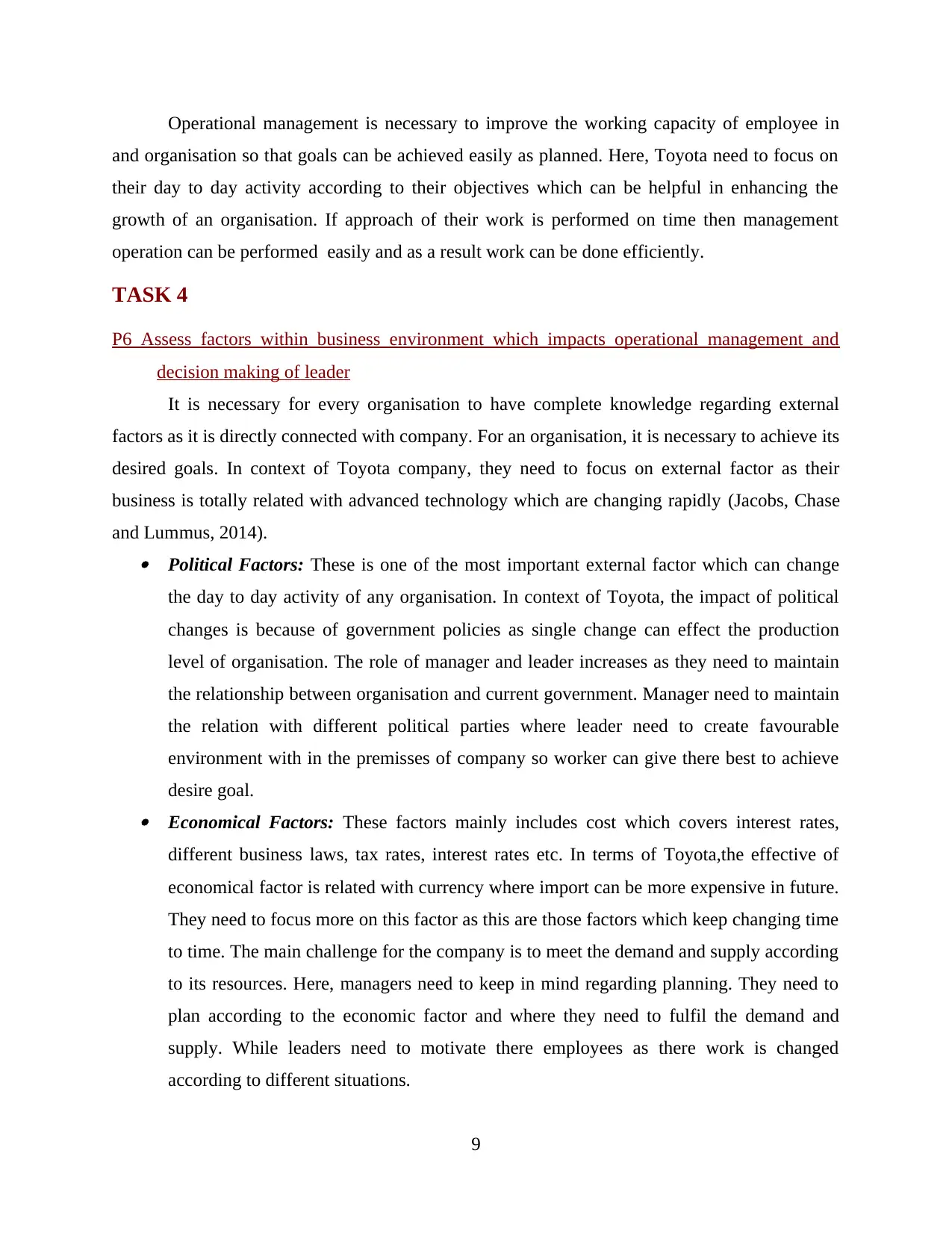
Operational management is necessary to improve the working capacity of employee in
and organisation so that goals can be achieved easily as planned. Here, Toyota need to focus on
their day to day activity according to their objectives which can be helpful in enhancing the
growth of an organisation. If approach of their work is performed on time then management
operation can be performed easily and as a result work can be done efficiently.
TASK 4
P6 Assess factors within business environment which impacts operational management and
decision making of leader
It is necessary for every organisation to have complete knowledge regarding external
factors as it is directly connected with company. For an organisation, it is necessary to achieve its
desired goals. In context of Toyota company, they need to focus on external factor as their
business is totally related with advanced technology which are changing rapidly (Jacobs, Chase
and Lummus, 2014). Political Factors: These is one of the most important external factor which can change
the day to day activity of any organisation. In context of Toyota, the impact of political
changes is because of government policies as single change can effect the production
level of organisation. The role of manager and leader increases as they need to maintain
the relationship between organisation and current government. Manager need to maintain
the relation with different political parties where leader need to create favourable
environment with in the premisses of company so worker can give there best to achieve
desire goal. Economical Factors: These factors mainly includes cost which covers interest rates,
different business laws, tax rates, interest rates etc. In terms of Toyota,the effective of
economical factor is related with currency where import can be more expensive in future.
They need to focus more on this factor as this are those factors which keep changing time
to time. The main challenge for the company is to meet the demand and supply according
to its resources. Here, managers need to keep in mind regarding planning. They need to
plan according to the economic factor and where they need to fulfil the demand and
supply. While leaders need to motivate there employees as there work is changed
according to different situations.
9
and organisation so that goals can be achieved easily as planned. Here, Toyota need to focus on
their day to day activity according to their objectives which can be helpful in enhancing the
growth of an organisation. If approach of their work is performed on time then management
operation can be performed easily and as a result work can be done efficiently.
TASK 4
P6 Assess factors within business environment which impacts operational management and
decision making of leader
It is necessary for every organisation to have complete knowledge regarding external
factors as it is directly connected with company. For an organisation, it is necessary to achieve its
desired goals. In context of Toyota company, they need to focus on external factor as their
business is totally related with advanced technology which are changing rapidly (Jacobs, Chase
and Lummus, 2014). Political Factors: These is one of the most important external factor which can change
the day to day activity of any organisation. In context of Toyota, the impact of political
changes is because of government policies as single change can effect the production
level of organisation. The role of manager and leader increases as they need to maintain
the relationship between organisation and current government. Manager need to maintain
the relation with different political parties where leader need to create favourable
environment with in the premisses of company so worker can give there best to achieve
desire goal. Economical Factors: These factors mainly includes cost which covers interest rates,
different business laws, tax rates, interest rates etc. In terms of Toyota,the effective of
economical factor is related with currency where import can be more expensive in future.
They need to focus more on this factor as this are those factors which keep changing time
to time. The main challenge for the company is to meet the demand and supply according
to its resources. Here, managers need to keep in mind regarding planning. They need to
plan according to the economic factor and where they need to fulfil the demand and
supply. While leaders need to motivate there employees as there work is changed
according to different situations.
9
⊘ This is a preview!⊘
Do you want full access?
Subscribe today to unlock all pages.

Trusted by 1+ million students worldwide
1 out of 16
Related Documents
Your All-in-One AI-Powered Toolkit for Academic Success.
+13062052269
info@desklib.com
Available 24*7 on WhatsApp / Email
![[object Object]](/_next/static/media/star-bottom.7253800d.svg)
Unlock your academic potential
Copyright © 2020–2025 A2Z Services. All Rights Reserved. Developed and managed by ZUCOL.





